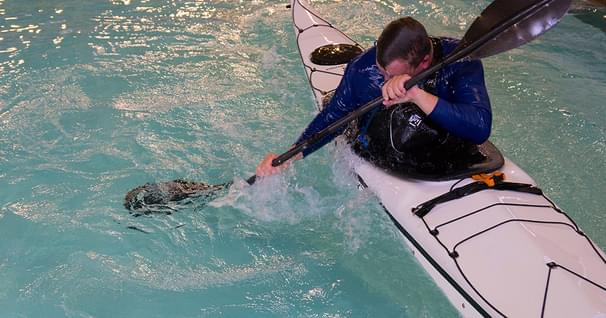Turning Your Kayak Quickly
To start your kayak turning, you want to use an initiation stroke, and that stroke requires your body to be looking or pointing in the direction that you want to turn, your blade close to the boat, and a short, powerful stroke to make the kayak turn. The stroke starts at the toes. Normally, the kayak is going to be edged toward the same side that you're doing the stroke on, that is, tilted towards that stroke side. The stroke will start at the toes, and you will unwind until you reach your body. So it doesn't go behind your body, it starts up at the bow of the kayak, and the stroke ends when it gets to your torso. That should push the kayak sharply towards the direction of the turn.
That, in conjunction with your edging, should give you a 90 degree turn, with just that one stroke. When we use the term "edging," in kayaking, we're referring to tilting our kayak onto its edge. So, right now, I am edged to the right, and I'm doing that by shifting my weight through the right side of my butt. And I am then tuning or balancing with a little pressure on my knee or thigh. I have my head over my tailbone, so I'm counter-balanced to be stable and steady. You want to be able to hold a steady edge, and that'll enhance your ability to make the kayak turn. These sorts of boats turn best when they're edged to the outside of the turn. So when I'm edged to the right, I am setting myself up to do a turn to the left. When you want your kayak to turn effectively, you'll want to use your brain, body, and boat, not just your paddle [blade].
With touring-type kayaks, including most rec and sea kayaks, they will turn most effectively when edged to the outside of the turn, using a short, efficient sweep stroke to initiate the turn. Once the kayak is turning, you want to hold a steady edge for as long as you want to continue turning.
We like to say, "The sequence is: Brain, Body, Boat, Blade."
- The brain decides to turn. You look where you want to go or into the turn.
- The body shifts the weight onto the outside edge, and then rotates into the turn.
- The boat is edged to the outside, as an example, for a right turn edge or tilt to the left.
This has been Mike Aronoff with Canoe Kayak and Paddle Company (CKAPCO). I hope we'll be seeing you on the water!
50 years of lightweight, maneuverable, high-performing kayaks.
Check out this interview with Tom Keane, Eddyline Kayaks Co-Owner, on their journey!
Related Articles
As the days get shorter and the weather gets colder, it becomes harder to get out and paddle and easier…
Mention “pool session” and the first image that pops into most kayakers minds is a class in how to roll.…
Paddling alone is a recipe for danger. Bring a buddy and stay safe on the water.




